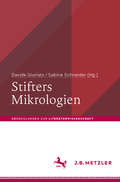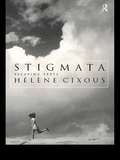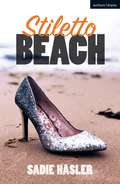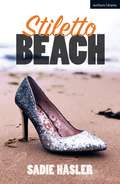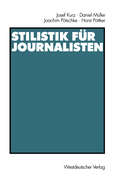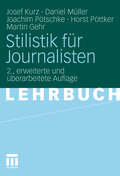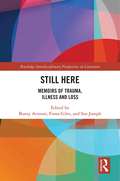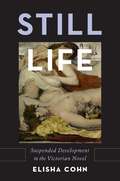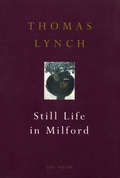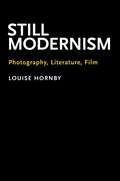- Table View
- List View
Stifter-Handbuch: Leben – Werk – Wirkung
by Christian Begemann Davide GuiriatoWie kaum ein anderer Autor des Realismus ist Adalbert Stifter in den letzten 25 Jahren grundlegenden Umdeutungen unterzogen worden. Zu seinem 150. Todestag bietet das Stifter-Handbuch nicht nur einen Überblick über sein Werk, dessen Entstehung und Rezeption sowie die verschiedenen Ansätze der literaturwissenschaftlichen Forschung, sondern setzt auch neue Akzente. Stifters Erzählungen, Romane und Aufsätze werden zum einen unter philologischen Gesichtspunkten und mit Blick auf neueste Forschungsergebnisse detailliert dargestellt, zum anderen in ihre poetologischen und ästhetischen Horizonte eingeordnet. Ausführlich untersucht werden die für Stifter maßgeblichen wissensgeschichtlichen Kontexte (wie etwa Botanik, Geologie, Meteorologie, Ökonomie, Pädagogik), bevor das Werk abschließend über bestimmte Problemfelder erschlossen wird (Ordnung, Wiederholung, Ritual, Dinge, Genealogie, Erbe u.a.).
Stifters Mikrologien (Abhandlungen zur Literaturwissenschaft)
by Davide Giuriato Sabine SchneiderDas Werk Adalbert Stifters zeichnet sich durch eine markante Aufmerksamkeit für das Kleine und vermeintlich Geringfügige aus, er gilt als Dichter des Details. Bereits die zeitgenössische Kritik hat sein „Diminutivtalent“ und Interesse für das „Kleinleben der Natur“ ins Visier genommen. So wie sich die Humanwissenschaften methodologisch auf die unwichtigen Nebensächlichkeiten, auf das Netz von geringfügigen Indizien und Symptomen zu stützen beginnen, so entdeckt dieser Sammelband Stifters Mikrologie als eine „unsichere Wissenschaft“, die sich gerade über unmerkliche Wahrnehmungen Aufschluss über größere Zusammenhänge erhofft. Der Zusammenhang von Literatur und Wissen, der hier aufgedeckt wird, bezieht sich auf Natur ebenso wie auf soziale Phänomene und beschreibt einen wesentlichen Aspekt der Poetologie Stifters.
Stigmata: Escaping Texts
by Hélène CixousA 'wilful extremist' according to the London Times, Hélène Cixous is hailed as one of the most formidable writers and thinkers of our time. Acclaimed by luminaries such as Jacques Derrida, her writing has nonetheless been misunderstood and misread, to a surprising extent. With the inclusion of Stigmata, one of her greatest works into the Routledge Classics series, this is about to change. Questions that have long concerned her – the self and the other, autobiographies of writing, sexual difference, literary theory, post-colonial theory, death and life – are explored here, woven into a stunning narrative. Displaying a remarkable virtuosity, the work of Cixous is heady stuff indeed: exciting, powerful, moving, and dangerous.
Stigmata: Escaping Texts
by Hélène CixousA 'wilful extremist' according to the London Times, Hélène Cixous is hailed as one of the most formidable writers and thinkers of our time. Acclaimed by luminaries such as Jacques Derrida, her writing has nonetheless been misunderstood and misread, to a surprising extent. With the inclusion of Stigmata, one of her greatest works into the Routledge Classics series, this is about to change. Questions that have long concerned her – the self and the other, autobiographies of writing, sexual difference, literary theory, post-colonial theory, death and life – are explored here, woven into a stunning narrative. Displaying a remarkable virtuosity, the work of Cixous is heady stuff indeed: exciting, powerful, moving, and dangerous.
Stigmata: Escaping Texts
by Hélène CixousHèléne Cixous -- author, playwright and French feminist theorist -- is a key figure in twentieth-century literary theory. Stigmata brings together her most recent essays for the first time.Acclaimed for her intricate and challenging writing style, Cixous presents a collection of texts that get away -- escaping the reader, the writers, the book. Cixous's writing pursues authors such as Stendhal, Joyce, Derrida, and Rembrandt, da Vinci, Picasso -- works that share an elusive movement in spite of striking differences. Along the way these essays explore a broad range of poetico-philosophical questions that have become characteristic of Cixous' work:* love's labours lost and found* feminine hours* autobiographies of writing* the prehistory of the work of artStigmata goes beyond theory, becoming an extraordinary writer's testimony to our lives and times.
Stigmata: Escaping Texts
by Hélène CixousHèléne Cixous -- author, playwright and French feminist theorist -- is a key figure in twentieth-century literary theory. Stigmata brings together her most recent essays for the first time.Acclaimed for her intricate and challenging writing style, Cixous presents a collection of texts that get away -- escaping the reader, the writers, the book. Cixous's writing pursues authors such as Stendhal, Joyce, Derrida, and Rembrandt, da Vinci, Picasso -- works that share an elusive movement in spite of striking differences. Along the way these essays explore a broad range of poetico-philosophical questions that have become characteristic of Cixous' work:* love's labours lost and found* feminine hours* autobiographies of writing* the prehistory of the work of artStigmata goes beyond theory, becoming an extraordinary writer's testimony to our lives and times.
Stiletto Beach (Modern Plays)
by Sadie HaslerBest mates Leanne and Kelly have lived in Southend-on-Sea their whole lives. Larger-than-life Leanne is happy staying put, but Kelly secretly dreams of escaping her dull job and seeing the world.When out-of-towner journalist Helen can't afford Leigh-on-Sea so moves in next door instead, events take a surprising turn. As Leanne and Kelly take her under their wing, an unexpected friendship blooms in Spoons, and Helen soon has them reconsidering what it means to celebrate where you're from.With the help of Leanne's Nan, east-ender Roni, they take a sharp swipe at stereotypes women have been putting up with for decades. Mischief ensues, fires are lit, and the Essex girls do what's in their blood: cause trouble – but not in a way anyone would expect…
Stiletto Beach (Modern Plays)
by Sadie HaslerBest mates Leanne and Kelly have lived in Southend-on-Sea their whole lives. Larger-than-life Leanne is happy staying put, but Kelly secretly dreams of escaping her dull job and seeing the world.When out-of-towner journalist Helen can't afford Leigh-on-Sea so moves in next door instead, events take a surprising turn. As Leanne and Kelly take her under their wing, an unexpected friendship blooms in Spoons, and Helen soon has them reconsidering what it means to celebrate where you're from.With the help of Leanne's Nan, east-ender Roni, they take a sharp swipe at stereotypes women have been putting up with for decades. Mischief ensues, fires are lit, and the Essex girls do what's in their blood: cause trouble – but not in a way anyone would expect…
Stilistik: Stiltheorien und Stilanalysen (Sammlung Metzler)
by Bernhard SowinskiIn diese zweite, überarbeitete und aktualisierte Auflage wurden neue Tendenzen und Fragestellungen der Stilistik aufgenommen; so z. B. historische Stilistik/Stilwandel oder interkulturelle/interlinguale Stilistik. Die jüngere Literatur zur Stilistik wurde eingearbeitet bzw. in der Bibliografie ergänzt.
Stilistik: Stiltheorien und Stilanalysen. Sammlung Metzler, 263 (Sammlung Metzler)
by Bernhard SowinskiStilistik für Journalisten
by Josef Kurz Daniel Müller Joachim Pötschke Horst PöttkerSprache ist das wichtigste Handwerkszeug des Journalisten, sie gekonnt zu handhaben die Grundlage für seinen Beruf und die Bewältigung seiner Aufgabe: das Herstellen von Öffentlichkeit. Dieses Lehrbuch ist die derzeit umfassendste Darstellung der journalistischen Stilkunde. Alle wichtigen Bereiche des journalistischen Sprachgebrauchs werden behandelt: Von der Wortwahl über die Satz- und Textgestaltung bis zu Stilverfahren bestimmter Genres wie Nachricht oder Kommentar und zum Jargon von Politikern. Die Stilistik ist für die journalistische Aus- und Weiterbildung sowie als Handbuch für den Gebrauch im Arbeitsalltag gedacht.
Stilistik für Journalisten
by Josef Kurz Daniel Müller Joachim Pötschke Horst Pöttker Martin GehrSprache ist neben dem Bild das wichtigste Handwerkszeug des Journalisten, sie gekonnt zu handhaben stellt die Grundlage für seine Berufstätigkeit und die Erfüllung seiner Aufgabe dar: das Herstellen von Öffentlichkeit. Dieses Lehrbuch ist die derzeit umfassendste Darstellung der journalistischen Stilkunde. Alle wichtigen Bereiche des journalistischen Sprachgebrauchs werden behandelt: von der Wortwahl über die Satz- und Textgestaltung bis zu Stilverfahren bestimmter Genres wie Nachricht, Kommentar oder Reportage und zum Jargon von Politikern. Die Stilistik ist für die journalistische Aus- und Weiterbildung sowie als Handbuch für den Gebrauch im Arbeitsalltag gedacht.
Still Here: Memoirs of Trauma, Illness and Loss (Routledge Interdisciplinary Perspectives on Literature)
by Bunty Avieson Fiona Giles Sue JosephStill Here: Memoirs of Trauma, Illness and Loss explores the history, ethics, and cross-cultural range of memoirs focusing on illness, death, loss, displacement, and other experiences of trauma. From Walt Whitman’s Civil War diaries to kitchen table survivor-to-survivor storytelling following Hurricane Katrina, from social media posts from a refugee detention centre, to poetry by exiles fleeing war zones, the collection investigates trauma memoir writing as healing, as documentation of suffering and disability, and as political activism. Editors Bunty Avieson, Fiona Giles and Sue Joseph have brought together this scholarly collection as a sequel to their earlier Mediating Memory (Routledge 2018), providing a closer look at the specific concerns of trauma memoir, including conflict and intergenerational trauma; the therapeutic potential and risks of trauma life writing; its ethical challenges; and trauma memoir giving voice to minority experiences.
Still Here: Memoirs of Trauma, Illness and Loss (Routledge Interdisciplinary Perspectives on Literature)
by Bunty Avieson Fiona Giles Sue JosephStill Here: Memoirs of Trauma, Illness and Loss explores the history, ethics, and cross-cultural range of memoirs focusing on illness, death, loss, displacement, and other experiences of trauma. From Walt Whitman’s Civil War diaries to kitchen table survivor-to-survivor storytelling following Hurricane Katrina, from social media posts from a refugee detention centre, to poetry by exiles fleeing war zones, the collection investigates trauma memoir writing as healing, as documentation of suffering and disability, and as political activism. Editors Bunty Avieson, Fiona Giles and Sue Joseph have brought together this scholarly collection as a sequel to their earlier Mediating Memory (Routledge 2018), providing a closer look at the specific concerns of trauma memoir, including conflict and intergenerational trauma; the therapeutic potential and risks of trauma life writing; its ethical challenges; and trauma memoir giving voice to minority experiences.
Still Learning to Read: Teaching Students in Grades 3–6
by Franki Sibberson Karen SzymusiakAuthors Franki Sibberson and Karen Szymusiak are back with an updated version of Still Learning to Read: Teaching Students in Grades 3-6, 2nd Edition. In the years since the first edition, prevalence of testing and Common Core State Standards have redefined requirements and what is expected of both teachers and students.This new edition focuses on the needs of students in grades 3-6 in for the following areas: reading workshops, read-alouds, classroom design, digital tools, fiction and nonfiction, and close reading. The authors examine current trends in literacy and introduce a new section on intentional instructional planning, as well as a new chapter on scaffolding for reading nonfiction. Expanded examples of lessons and routines to promote deeper thinking about learning are also included.In Still Learning to Read, you'll also find online videos that provide insight into classrooms. Students make book choices, work in small groups, and discuss their reading notebooks. Finally, updated and expanded book lists, recommendations for digital tools, lesson cycles, and sections for school leaders round out this foundational resource.
Still Learning to Read: Teaching Students in Grades 3–6
by Franki Sibberson Karen SzymusiakAuthors Franki Sibberson and Karen Szymusiak are back with an updated version of Still Learning to Read: Teaching Students in Grades 3-6, 2nd Edition. In the years since the first edition, prevalence of testing and Common Core State Standards have redefined requirements and what is expected of both teachers and students.This new edition focuses on the needs of students in grades 3-6 in for the following areas: reading workshops, read-alouds, classroom design, digital tools, fiction and nonfiction, and close reading. The authors examine current trends in literacy and introduce a new section on intentional instructional planning, as well as a new chapter on scaffolding for reading nonfiction. Expanded examples of lessons and routines to promote deeper thinking about learning are also included.In Still Learning to Read, you'll also find online videos that provide insight into classrooms. Students make book choices, work in small groups, and discuss their reading notebooks. Finally, updated and expanded book lists, recommendations for digital tools, lesson cycles, and sections for school leaders round out this foundational resource.
Still Life: Suspended Development in the Victorian Novel
by Elisha CohnStill Life: Suspended Development in the Victorian Novel rethinks the nineteenth-century aesthetics of agency through the Victorian novel's fascination with states of reverie, trance, and sleep. These states challenge contemporary scientific and philosophical accounts of the perfectibility of the self, which privileged reflective self-awareness. In dialogue with the field of literature and science studies and affect studies, this book shows how Victorian writers used narrative form to respond to the analytical practices and knowledge production of those other disciplines. Drawing upon canonical texts--by Charlotte Brontë, George Eliot, George Meredith, and Thomas Hardy--Still Life contends that depictions of non-purposive perceptual experience suspend the processes of self-cultivation (Bildung) central to Victorian aesthetics, science, psychology, and political theory, as well as most critical accounts of the novel form. Departing from the values of individual cultivation and moral revelation associated with the genre, these writers offer an affective framework for understanding the subtly non-instrumental powers of narrative. Victorian novels ostensibly working within the parameters of the Bildungsroman are suspended by moments of "still life": a decentered lyricism associated with states of diminished consciousness. They use this style to narrate what should be unnarratable: experiences not dependent on reflective consciousness, which express a distinctive ambivalence toward dominant developmental frameworks of individual self-culture.
Still Life: Suspended Development in the Victorian Novel
by Elisha CohnStill Life: Suspended Development in the Victorian Novel rethinks the nineteenth-century aesthetics of agency through the Victorian novel's fascination with states of reverie, trance, and sleep. These states challenge contemporary scientific and philosophical accounts of the perfectibility of the self, which privileged reflective self-awareness. In dialogue with the field of literature and science studies and affect studies, this book shows how Victorian writers used narrative form to respond to the analytical practices and knowledge production of those other disciplines. Drawing upon canonical texts--by Charlotte Brontë, George Eliot, George Meredith, and Thomas Hardy--Still Life contends that depictions of non-purposive perceptual experience suspend the processes of self-cultivation (Bildung) central to Victorian aesthetics, science, psychology, and political theory, as well as most critical accounts of the novel form. Departing from the values of individual cultivation and moral revelation associated with the genre, these writers offer an affective framework for understanding the subtly non-instrumental powers of narrative. Victorian novels ostensibly working within the parameters of the Bildungsroman are suspended by moments of "still life": a decentered lyricism associated with states of diminished consciousness. They use this style to narrate what should be unnarratable: experiences not dependent on reflective consciousness, which express a distinctive ambivalence toward dominant developmental frameworks of individual self-culture.
Still Life In Milford: Poems (Cape Poetry Ser.)
by Thomas LynchIn Still Life in Milford, Lynch casts the cold eye we are told to on life and death, history and memory, the local and the larger geographics. Examining the dynamics of faith, remembrance, and intimate conduct, these poems are informed by end times, tribulations and visions that make up the ordinary enterprise of daily life. Colloquy and narrative, soliloquy and tribute, Still Life in Milford engages the full register of the poet's voices as elegist, eulogist, obituarist, straight man and passer-by to achieve a difficult and inimitable harmony.
Still Life with Rhetoric: A New Materialist Approach for Visual Rhetorics
by Laurie GriesWinner of the 2016 CCCC Advancement of Knowledge Award and the 2016 CCCC Research Impact Award In Still Life with Rhetoric, Laurie Gries forges connections among new materialism, actor network theory, and rhetoric to explore how images become rhetorically active in a digitally networked, global environment. Rather than study how an already-materialized “visual text” functions within a specific context, Gries investigates how images often circulate and transform across media, genre, and location at viral rates. A four-part case study of Shepard Fairey’s now iconic Obama Hope image elucidates how images reassemble collective life as they actualize in different versions, enter into various relations, and spark a firework of activity across the globe. While intent on tracking the rhetorical life of a single, multiple image, Still Life with Rhetoric is most concerned with studying rhetoric in motion. To account for an image’s widespread circulation and emergent activities, Gries introduces iconographic tracking—a digital research method for tracing an image’s divergent rhetorical becomings. Yet Gries also articulates a dynamic set of theoretical principles for studying rhetoric as a distributed, generative, and unforeseeable event that is applicable beyond the study of visual rhetoric. With an eye toward futurity—the strands of time beyond a thing’s initial moment of production and delivery—Still Life with Rhetoric intends to be taken up by those interested in visual rhetoric, research methods, and theory.
Still Lost in Translation: More misadventures in English abroad
by Charlie CrokerHave you ever arrived in a hotel room and been baffled by the information provided? Beware of your luggage.In your room you will find a minibar which is filled with alcoholics. Do not throw urine around.Have you ever been to a restaurant and wondered what on earth to order?Bored Meat StewLorry Driver SoupKiss LorraineHave you ever arrived in an airport and found that the supposedly helpful signs just make you feel more lost?You are required to declare all sorts of private things.Departure. Bus stop. Car rectal.Please buy your ticket consciously.Charlie Croker has, and in 2006 he gathered together what he thought was the definitive collection of English language howlers for his bestselling book Lost in Translation. But he reckoned without the great British public. Not only was the book a smash hit, it also opened the floodgates to a deluge of emails and letters stuffed full of further mistranslations and mutilated phrases. From a leaflet from the Museum of Rasputin in Russia (which is apparently situated in a house that belonged a pilot fish Zubov) to a song title on a pirated Pink Floyd CD (Come Fartably Numb), the scrambled sentences just kept flooding in. At the same time Charlie has continued his travels and picked up gems of his own. With such a wealth of material, a sequel wasn't just a necessity, it was a public service, and Still Lost in Translation is even more addictive, whimsical and side-splittingly hilarious than the first book.
Still Modernism: Photography, Literature, Film
by Louise HornbyStill Modernism offers a critique of the modernist imperative to embrace motion, speed, and mobility. In the context of the rise of kinetic technologies and the invention of motion pictures, it claims that stillness is nonetheless an essential tactic of modernist innovation. More specifically, the book looks at the ways in which photographic stillness emerges as a counterpoint to motion and to film, asserting its own clear visibility against the blur of kinesis. Photographic stillness becomes a means to resist the ephemerality of motion and to get at and articulate something real or essential by way of its fixed limits. Combining art history, film studies and literary studies, Louise Hornby reveals how photographers, filmmakers, and writers, even at their most kinetic, did not surrender attention to points of stillness. Rather, the still image, understood through photography, establishes itself as a mode of resistance and provides a formal response to various modernist efforts to see better, to attend more closely, and to remove the fetters of subjectivity and experience. Still Modernism brings together a series of canonical texts, films, and photographs, the selection of which reinforces the central claim that stillness does not lurk at the margins of modernism, but was constitutive of its very foundations. In a series of comparisons drawing from literary and visual objects, Hornby argues that still photography allows film to access its own diffuse images of motion; photography's duplicative form provides a serial structure for modernist efforts to represent the face; its iterative structure articulates the jerky rhythms of experimental narrative as perambulation; and its processes of development allow for the world to emerge independent of the human observer. Casting new light on the relationship between photography and film, Hornby situates the struggle between the still and the kinetic at the center of modernist culture.
Still Modernism: Photography, Literature, Film
by Louise HornbyStill Modernism offers a critique of the modernist imperative to embrace motion, speed, and mobility. In the context of the rise of kinetic technologies and the invention of motion pictures, it claims that stillness is nonetheless an essential tactic of modernist innovation. More specifically, the book looks at the ways in which photographic stillness emerges as a counterpoint to motion and to film, asserting its own clear visibility against the blur of kinesis. Photographic stillness becomes a means to resist the ephemerality of motion and to get at and articulate something real or essential by way of its fixed limits. Combining art history, film studies and literary studies, Louise Hornby reveals how photographers, filmmakers, and writers, even at their most kinetic, did not surrender attention to points of stillness. Rather, the still image, understood through photography, establishes itself as a mode of resistance and provides a formal response to various modernist efforts to see better, to attend more closely, and to remove the fetters of subjectivity and experience. Still Modernism brings together a series of canonical texts, films, and photographs, the selection of which reinforces the central claim that stillness does not lurk at the margins of modernism, but was constitutive of its very foundations. In a series of comparisons drawing from literary and visual objects, Hornby argues that still photography allows film to access its own diffuse images of motion; photography's duplicative form provides a serial structure for modernist efforts to represent the face; its iterative structure articulates the jerky rhythms of experimental narrative as perambulation; and its processes of development allow for the world to emerge independent of the human observer. Casting new light on the relationship between photography and film, Hornby situates the struggle between the still and the kinetic at the center of modernist culture.
Still Thriving: On the Importance of Aranye Fradenburg
by L.O. Aranye Fradenburghe work of L.O. Aranye Fradenburg, especially her psychoanalytic criticism of Chaucer, and her formulations of discontinuist historical approaches to the Middle Ages, has been extremely influential within medieval studies for the past 20 or so years. More recently she has been focusing on more broad defenses of the humanities, especially with regard to the valuable role of literary studies relative to the arts of everyday living, eudaimonia [flourishing], ethical community, and well-being, and also on psychoanalysis itself as a “liberal art.” Relationality, intersubjectivity, aliveness, resilience, care of the self and also of others, adaptive flexibility, playfulness, shared attention, companionship, healing, and thriving seem, increasingly, to be the key watchwords and concerns of Fradenburg’s work, and at the same time, the so-called “literary” mode is still central to these concerns, such that, as Fradenburg has written, “Interpretation and relationality depend on one another because all relationships are unending processes of interpretation and expression, listening and signifying. In turn, sentience assists relationality: we can’t thrive and probably can’t survive without minds open to possibility, capable of sensing and interpreting the tiniest shifts in, e.g., pitch and tone.” This small volume features short essays and personal reflections on the importance of Fradenburg’s career, as teacher and scholar, and also on the valuable role(s) that her work, and medieval studies more generally, has played and might still play in the defense of the humanities as essential to living and thriving.

